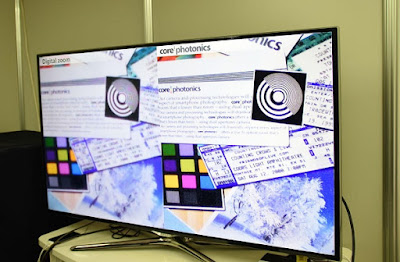Looks like, just as is the case with Jamaican women,
two cameras is better than one.
Corephotonics, a Israeli startup specializing in
camera optics, has developed a new
dual-camera system for smartphones as reported in the article “The
future of smartphones is in dual cameras”, published February 22, 2016 by
Aloysius Low, CNET News.
Their product, which was on show at MWC (Mobile
World Congress) 2016 from Monday February 22nd 2016 to Thursday
February 25th 2016, trumps bigger screens and faster processor.
Their dual-camera system will make optical zoom possible while reducing excess
light reaching the CCD (Charge Couple Device) making for cleaner, more balance
pictures.
But more interestingly as far as I'm, concerned, it would
lead to a push towards 3D imaging, allowing for smartphone user to take 3D
images of object and their surroundings. They could then take these images and
reproduce them in a 3D printer, working in much the same way that Caltech's 3D
scanning using LIDAR works as explained in my blog article
entitled “@Caltech's
Portable 3D Scanning Device - How portable 3D Scanning using LIDAR gives a
boost to 3D Printing revolution”.
This tech is set to be a huge gamechanger in the
smartphone world, as most Smartphone cameras can take pictures, albeit they
can't beat dSLR from even our local photographers in St. Williams Grant Park as
explained in my MICO Wars
blog article entitled “How
the Photographers of St William Grant Park are beating smartphone Selfies”.
Optical zoom, a requirement among most professional
photographers, means that Smartphone need to have a lens attachment to achieve
this effect as pointed out in my Geezam blog article entitled “How
to take High Quality Photographs with the Samsung Galaxy S6”.
So how does the Corephotonics dual-camera system
make a difference?
Corephotonics
dual-camera system - Smartphones Optical Zoom for filming VR Content
This won't be the first time that the Smartphone biz
has dabbled in 3D imaging. HTC Evo 3D used dual cameras to take 3D images, but
idea failed to spark the imagination of the masses.
Not this time though; this time, we have VR (Virtual
Reality) and Augmented Reality as was evidence at CES (Computer Electronics
Show) 2016 as noted in my Geezam blog article
entitled “How
CES 2016 is going VR thanks to HTC, Sony, Microsoft, Samsung and Oculus and now
at MWC 2016”, which had splashes of VR interspersed among the usual
smartphone launches.
These is now a need for Camera systems that can take
panoramic images that can be use a content for VR Headset such as the Samsung
Gear VR, the HTC Vive and even the Facebook Oculus Rift.
Already Samsung, sensing the coming demand, has
outed the Samsung Gear 360, a VR Camera for the very creative as described in my
Geezam blog article entitled “How
Samsung Gear 360 is a Creative Tool for YouTube VR Content”.
Corephotonics dual-camera system isn't a panoramic
camera system. Rather, it's mean to be a component module option for smartphone
makers wishing to gift their photographer crowd that totes around a Smartphone
another reason to use the camera for more professional photos. Their tech works
by using two cameras:
1. One
fixed-focus telephoto with a narrow field of view
2. One
normal wide-angle camera
Currently Corephotonics has three (3) module
versions of their dual-camera system:
1. 13-megapixel
and an 8-megapixel camera
2. 2
13-megapixel cameras
3. 2
13-megapixel cameras called “Hawkeye”
The 13-megapixel and an 8-megapixel camera gives a
maximum optical zoon of 5X without the loss of detail or increased pixellation.
The second model has one of the 13-megapixel cameras being capable of filming
in black and white only and is best for high contrast shots with lots of light
and shadows. The Third combination, affectionately called Hawkeye, uses a
proprietary tech in one of the 13-megapixel lens to achieve a 5x optical zoom
and improved optical image stabilization.
Corephotonics dual-camera system combined with build
in algorithms, would result in images with the following much desired
properties among photographers:
1. Higher
resolution in close shots
2. Noise
reduction in low light
3. Increased
dynamic range
4. Better
Depth analysis
Expect Samsung's Exynos and Mediatek's processors to
provide software support and integration into Smartphone makers that use their
chips, expanding beyond their Qualcomm Snapdragon partnership, currently the
only platform that's Corephotonics dual-camera system ready.
3D pictures, ready for VR with a high resolution and
capable of near 5x zoom without pixilation is something that'll make
photographers give the smartphone as a camera replacement a second look.



No comments:
Post a Comment